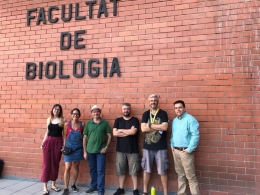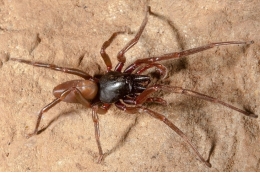05-09-2019
UB and IRBio experts sequence the genome of an endemic spider from the Canary Islands
A research team of the Faculty of Biology and the Biodiversity Research Institute (IRBio) of the University of Barcelona has sequenced the genome of the spider Dysdera silvatica Schmidt 1981, an endemic species living in the laurel forests in the islands La Gomera, La Palma, and El Hierro –in the Canary Islands. The new study reveals the first genome sequencing of an arthropod in the Canary Islands, an archipelago with a rich biodiversity regarding endemic species that are distributed around the insular area.
Participants in the new study, published in the journal GigaScience, are the experts Julio Rozas, Miquel Arnedo, José Francisco Sánchez-Herrero, Cristina Frías-López, Paula Escuer, Silvia Hinojosa-Alvarez and Alejandro Sánchez-Gracia (UB-IRBio).
This is the first sequencing of the nuclear and mitochondrial genome for a species of the Dysderoidea superfamily, and the second one known in the Synspermiata group, one of the main spider lineages.
According to the conclusions, the genome of the D. silvatica species is large (1.7 Gb) and shows a high complexity, with a high fraction of repetitive elements. According to Professor Julio Rozas (UB-IRBio), who co-led the study together with Alejandro Sánchez-Garcia, “Within this study, we created a 1.4 Gb genomic sequencing assembly, 54 % of which is built by repetitive elements”.
“We identified and characterized a total of 36,000 protein-coding gens”, notes Professor Julio Rozas (UB-IRBio), head of the research group on Evolutionary Genomics and Bioinformatics at the UB, part of the platform Bioinformatics Barcelona (BIB).
The research team completed these data with PacBio and Nanopore single molecule sequencing (SMS) techniques, “more expensive but more efficient methodologies to obtain larger genome sequencing, and provide a quality genomic assembly using the hybrid assembly strategy, combining data from the obtained sequencing through different technologies”, notes José Francisco Sánchez-Herrero, member of the Department of Genetics, Microbiology and Statistics of IRBio and first author of the article.
From a global perspective, the study brings new views to know more about the genetic bases of the eco-phenotype change that takes place during the adaptive radiation phenomena over biological evolution.
Last, the study provides useful resources to treat studies on other evolutionary and essential issues, such as the origins and evolution of products with medical and commercial interests produced by spiders (venom, silk, etc.).
More information

From left to right, the researchers Paula Escuer, Cristina Frías-Lopez, Julio Rozas, Alejandro Sanchez-Gracia, Miquel Arnedo and José F. Sanchez-Herrero.
Participants in the new study, published in the journal GigaScience, are the experts Julio Rozas, Miquel Arnedo, José Francisco Sánchez-Herrero, Cristina Frías-López, Paula Escuer, Silvia Hinojosa-Alvarez and Alejandro Sánchez-Gracia (UB-IRBio).
This is the first sequencing of the nuclear and mitochondrial genome for a species of the Dysderoidea superfamily, and the second one known in the Synspermiata group, one of the main spider lineages.
According to the conclusions, the genome of the D. silvatica species is large (1.7 Gb) and shows a high complexity, with a high fraction of repetitive elements. According to Professor Julio Rozas (UB-IRBio), who co-led the study together with Alejandro Sánchez-Garcia, “Within this study, we created a 1.4 Gb genomic sequencing assembly, 54 % of which is built by repetitive elements”.
“We identified and characterized a total of 36,000 protein-coding gens”, notes Professor Julio Rozas (UB-IRBio), head of the research group on Evolutionary Genomics and Bioinformatics at the UB, part of the platform Bioinformatics Barcelona (BIB).
The research team completed these data with PacBio and Nanopore single molecule sequencing (SMS) techniques, “more expensive but more efficient methodologies to obtain larger genome sequencing, and provide a quality genomic assembly using the hybrid assembly strategy, combining data from the obtained sequencing through different technologies”, notes José Francisco Sánchez-Herrero, member of the Department of Genetics, Microbiology and Statistics of IRBio and first author of the article.
From a global perspective, the study brings new views to know more about the genetic bases of the eco-phenotype change that takes place during the adaptive radiation phenomena over biological evolution.
Last, the study provides useful resources to treat studies on other evolutionary and essential issues, such as the origins and evolution of products with medical and commercial interests produced by spiders (venom, silk, etc.).
More information

From left to right, the researchers Paula Escuer, Cristina Frías-Lopez, Julio Rozas, Alejandro Sanchez-Gracia, Miquel Arnedo and José F. Sanchez-Herrero.
